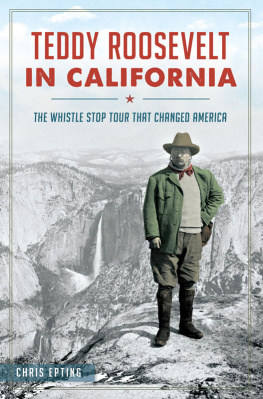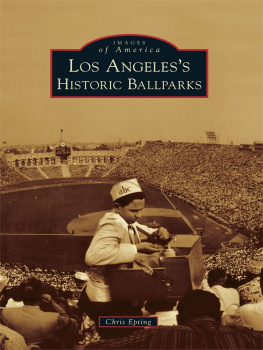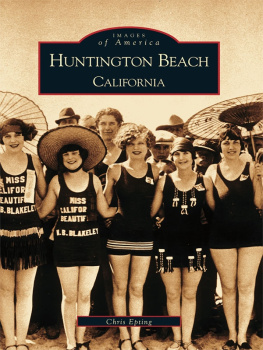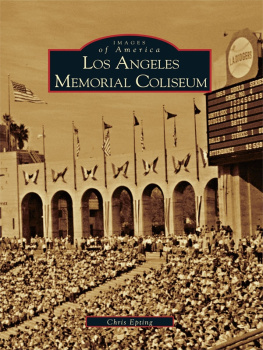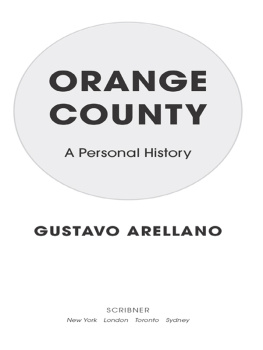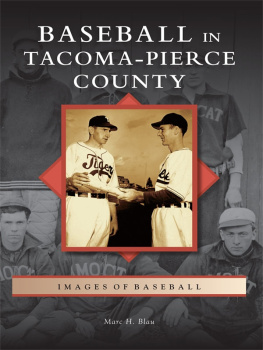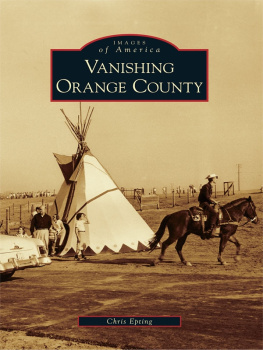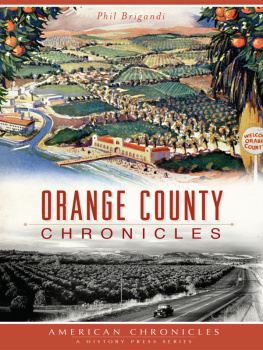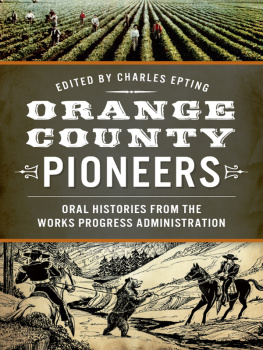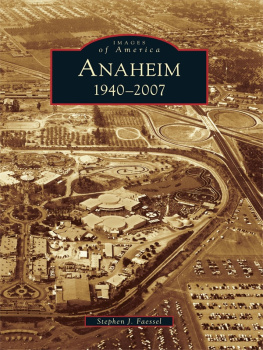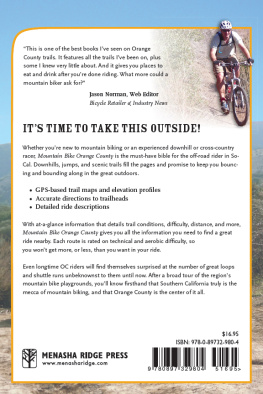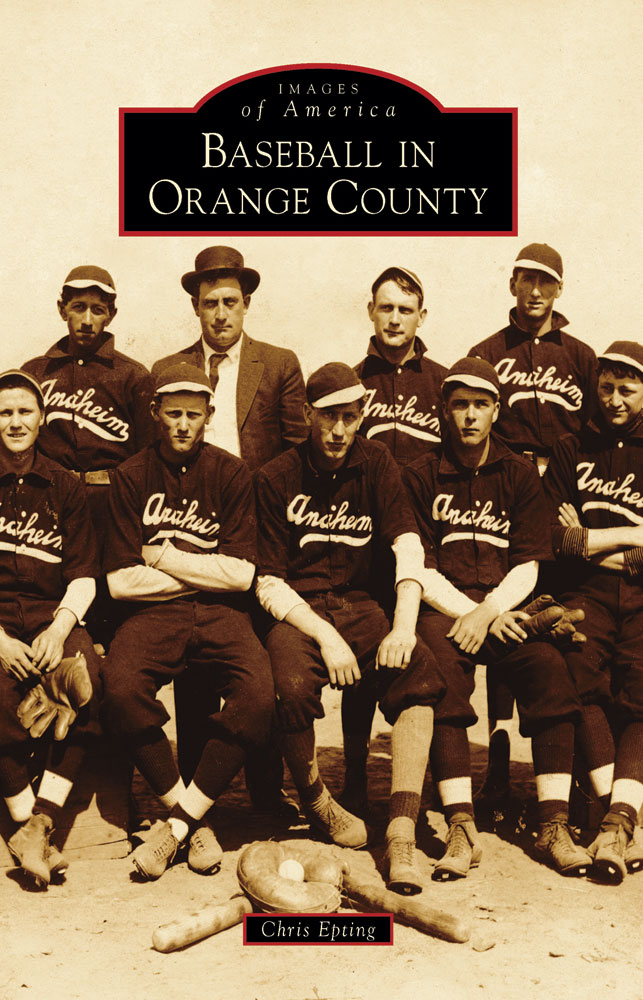
IMAGES
of America
BASEBALL IN
ORANGE COUNTY
ON THE COVER: This is a c. 1909 photograph of the Anaheim Oil Wells baseball team. (Courtesy of Anaheim Heritage Center.)
IMAGES
of America
BASEBALL IN
ORANGE COUNTY
Chris Epting

Copyright 2012 by Chris Epting
ISBN 978-0-7385-9328-9
Ebook ISBN 9781439642245
Published by Arcadia Publishing
Charleston, South Carolina
Library of Congress Control Number: 2011943765
For all general information, please contact Arcadia Publishing:
Telephone 843-853-2070
Fax 843-853-0044
E-mail
For customer service and orders:
Toll-Free 1-888-313-2665
Visit us on the Internet at www.arcadiapublishing.com
To Brian Nicalek, who is as passionate and knowledgeable as any Orange County baseball fan that ever entered a ballpark
CONTENTS
History books like this are truly labors of love and would not be possible without the generosity, time, and consideration of many people and resources. I would like to acknowledge and thank Jane K. Newell, heritage services manager at the Anaheim Public Library; Richard Santillan, whose wonderful research on Mexican baseball heritage in Southern California has already produced two fine Arcadia books (with more to come); Cheri Pape, curator at the Local History Room at the Fullerton Public Library; Lizeth Ramirez, local history librarian at the Orange Public Library; Irma Morales Sr., library manager at the Orange Public Library; Chris Jepsen at the Orange County Archives; Terry Canon from the Baseball Reliquary; Hank Thomas and Chuck Carey for their tremendous research on Walter Johnson; Wendy Kotkosky for her Huntington Beach Little League photographs (her son Stevens home run in the sixth inning of Western Regionals put the team in the Little League World Series); the Newport Sports Museum; and Tom Meigs, Tom Duino, Richard Wojcik, and John Outland for their wonderful photographs.
Gratitude also goes to Amy Perryman and her fine team at Arcadia Publishing and Jerry Roberts for suggesting this book idea in the first place.
And, of course, to my wife, Jean, daughter Claire and son Charlesthanks for always being the best home team in the world.
Some images in this volume appear courtesy of the Anaheim Public Library, Fullerton Public Library, Orange Public Library, and Orange County Archives. Unless otherwise noted, all other images are property of the author.
For many Orange County baseball fans, the arrival of the California Angels in 1966 all but heralded the beginning of real baseball history in the areaand that is understandable. After all, since arriving in 1958 in nearby Los Angeles after relocating from Brooklyn, the Dodgers had commanded immense attention, and for many the Angels put Orange County baseball on the map.
But just like the rich preDodger baseball era in the Los Angeles area, Orange County also boasted an impressive amount of history. It may not have been at the major-league level, which justifiably generates a high amount of attention and enthusiasm, but it was still extremely important to many locals and actually helped set the stage for the arrival of the Angels.
Going all the way back to the late 1800s, baseball played a very important part in the development of Orange County. Everyone knows the Angels, but many are unaware that Walter Johnson, one of the greatest pitchers in baseball history, learned to play baseball in Orange County, or that he returned in 1924 to play a now-legendary game against a team led by Babe Ruth.
Many do not know how organized the oil well teams were in the early 1900s and how oil companies actually recruited strong, young players so they could have the most dominant teams.
And there is much more to the story of Orange County baseball history. Jackie Robinson came to Anaheim to film the story of his life at a little ballpark called La Palma, which is also the place where Joe DiMaggio played while stationed in the Army. It is also the spot where the Anaheim Valencias won the Sunset League championship in 1947, as well as where manager Connie Mack brought his Philadelphia Athletics for spring training in the early 1940s.
There was the Southern California Trolley League, which was only in existence in 1910, featuring teams that were connected by trolleys running between their cities. Orange Countys league entry was the Santa Ana Yellow Sox, which was joined by the Redondo Beach Wharf Rats, Long Beach Sand Crabs, Los Angeles McCormicks, Pasadena Silk Sox, and Los Angeles Maiers.
There were the Mexican players who, shamefully, were not allowed to play with white teams due to segregation, so they formed teams, like Los Juveniles, that played in their own leagues.
There was the legendary female team the Orange Lionettes and famed ballparks like the aforementioned La Palma Park, Amerige Park in Fullerton, and Hawley Park in Santa Ana.
What about the day Yankee legends Babe Ruth and Lou Gehrig came to Orange County to hunt? Speaking of Babe Ruth, did you know his last-ever home run ball is located in an Orange County museum that features one of the worlds greatest collections of baseball artifacts?
There are many other players, stories, anecdotes, bits of trivia, and revelations about Orange County baseball. They are all part of the story and are here, along with many extremely rare photographs, representing the full story of the history of baseball in Orange County.
Then, of course, there are the Angels, who played their first game in Orange County in 1966. While it would have been easy (and interesting) to primarily focus on the Angels given their own 50-year history, that is not what this book sets out to do. There are several fine books that document Angels history, and given the space I had to work with, I chose to focus my emphasis on their arrival in Orange County, the construction of their ballpark (Angel Stadium), and several other key franchise events.
Also, while it would have been nice to feature every ballplayer from the area, along with every player laid to rest in Orange County, due to space limitations I chose the players who seemed to best represent the sport.
I chose to organize the book into seven chapters. It begins with the arrival of a teenaged Walter Johnson in the early 1900s and traces his footsteps throughout Orange County. Next, it is on to the first full era of Orange County baseball (1880 to 1930), when many high school teams and organized leagues had begun, along with a host of semiprofessional teams. It then goes on to a chapter dedicated to a near-mythical game that took place in Brea on October 31, 1924, when Walter Johnson returned home to play against a team fronted by Babe Ruth. What makes this chapter truly unique are the rare photographs taken that memorable day by George Outland, which are presented here for the first time. Chapter four captures the mid-century baseball history, a time when stars such as Jackie Robinson and Joe DiMaggio played here and Orange County became a popular spring-training destination. After that, it is time to look at the arrival of the California Angels and some of the more well-known players who hail from Orange County. Finally, readers will enjoy a mixed bag of sorts, a chapter that includes baseball plaques, markers, memorials, museums, and final resting places that all have an Orange County baseball connection.
I hope you find there is more than enough here to make the case that the baseball history in Orange County is compelling and significant. Starting with Walter Johnson and ending with a breathtaking 2011 Little League World Series Championship, the county once defined by citrus groves and oil fields has been a hotbed of baseball activity since the time it was founded in 1889 (there was actually already organized baseball in Orange County that year, as you will learn).
Next page

